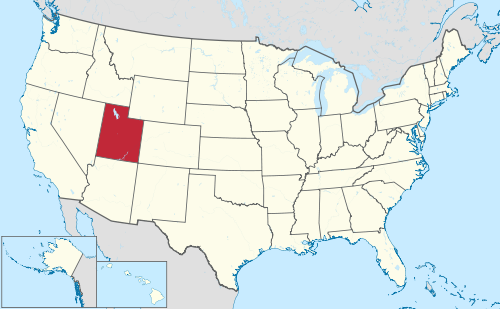| Capital city | Salt Lake City |
| Biggest city | Salt Lake City |
| Surface | 219,887 km² |
| Population | 3,338,000 |
| Length of highway network | 1,529 km |
| First highway | 1956 |
| Abbreviation | UT |
Utah is a state in the western United States. The capital and largest city is Salt Lake City. The state has 3.3 million inhabitants (2021) and has an area of 219,887 square kilometers, more than 5 times the size of the Netherlands.
Geography
I-15 near Nephi, with a view of Mount Nebo (3635 m).
Utah is located in the Intermountain West region, just west of the Rocky Mountains. The state borders Idaho, Wyoming, Colorado, Arizona and Nevada, and also New Mexico through the ‘Four Corners’. Utah is a large state, it measures a maximum of 555 kilometers from north to south and 445 kilometers from west to east. Utah’s borders are in the shape of a square. Eastern Utah is predominantly mountainous with isolated mountain ranges and broad canyoned valleys. The 4,120-meter high Kings Peak is the highest point in the state. Western Utah is flatter and consists of almost uninhabited desert. Special is the Great Salt Lake in the north, and the Bonneville Salt Flats located next to it. Utah is home to several national parks, such as Zion National Park, Bryce Canyon National Park, Capitol Reef National Park, Arches National Park, and Canyonlands National Park. The south of the state has special features, such as Monument Valley, Valley of the Gods,
Few major rivers flow through Utah, the most important being the Colorado River in the southeastern part of the state, of which the Green River is a major tributary. Utah is predominantly barren, only higher mountain areas are forested. The mountain ranges run north-south through Utah, with a large concentration of high mountain ranges in the northeast of the state. In addition to the Great Salt Lake, Utah Lake and Bear Lake are also large lakes.
Utah has a dry desert climate with cold winters and hot summers. However, the climate varies according to altitude. The average maximum temperature in Salt Lake City is 3°C in winter and 34°C in summer.
Economy
Utah ranks high on many economic indicators and is one of the more prosperous states in the country. The economy has traditionally been mining, especially large open mines west of Salt Lake City. Oil and gas is extracted in eastern Utah. Tourism plays an important role, especially the national parks in the south of the state are much visited. There are also ski areas around Salt Lake City.
Demographics
| City | Population |
| Salt Lake City | 200,000 |
| West Valley City | 139,000 |
| West Jordan | 117,000 |
| Provo | 114,000 |
| St. George | 100,000 |
| Orem | 98,000 |
Utah is a fast growing state. In the 1960s, the state crossed the 1 million inhabitants mark, and the 2 million inhabitants mark in the 1990s. Population of Utah is highly concentrated in the so-called ‘Wasatch Front’, an elongated urban area in the north of the state, which includes Salt Lake City fall. Also included are cities such as Ogden, Farmington, Orem and Provo. In the south of the state, St. George is one of the fastest-growing small towns in the country, surpassing the 100,000 population mark in 2021. However, large parts of the state are sparsely populated or even uninhabited, especially in the west and southeast. Utah is a relatively white state, there are very few African Americans, but quite a lot of Hispanics. A large proportion of Utahns are Mormons, for which the state is internationally known.
History
The first Europeans in the area were Spaniards in 1540. The area was not colonized until the 19th century due to the harsh climate. The area became part of Mexico in 1821 when that country became independent, and belonged to Alta California. It was not until the first half of the 19th century that Americans arrived in Utah from the east, Jim Bridger was the first American to see the Great Salt Lake in 1824. From then on, migrants began traveling west through Utah. Beginning in 1847, the area was inhabited by Mormons, particularly around Salt Lake City. During the Mexican-American War of 1846-1848, the United States conquered the Alta California area, which was subsequently ceded by Mexico.
In 1850, the Utah Territory was organized. This was larger than the present state, and also included almost all of Nevada, western Colorado, and southwestern Wyoming. In 1861, the Nevada Territory was separated, followed shortly after by the Colorado Territory. In 1869 the last section of the transcontinental railway was completed at Promontory. Utah became the 45th state of the United States in 1896. In the early 20th century, Utah became known for its natural beauty and the first national parks were established. The Wasatch Range is known for some of the best snow conditions in the world, and Salt Lake City’s fame grew after the Winter Olympics were held there in 2002.
